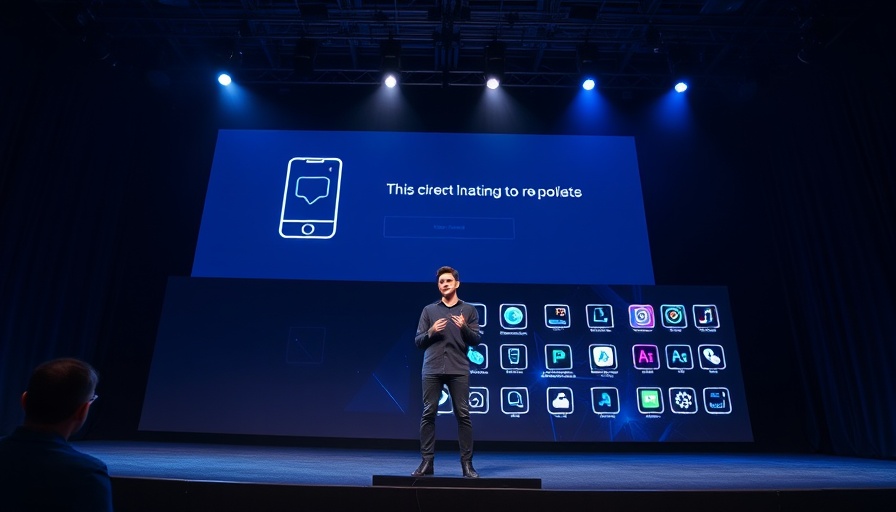
Meta's Bold Move: The Standalone AI App Revolution
In a strategic leap into the artificial intelligence sphere, Meta is poised to launch a standalone AI application in the second quarter of 2025. This ambitious project aims to directly compete with established giants such as OpenAI's ChatGPT and Google's Gemini. With CEO Mark Zuckerberg stating that Meta AI could reach a staggering one billion users this year, the launch promises to reshape the competitive landscape of AI technology.
The Underlying Strategy of Meta's AI App
Meta's decision to create a standalone AI app is a tactical response to the rapidly evolving demands of both consumers and market dynamics. Currently integrated into popular platforms like Facebook, Instagram, and WhatsApp, the new app is designed to enhance user interaction by providing an enhanced, focused AI experience free from the constraints of larger social media ecosystems. This shift allows Meta not just to improve existing functionalities but to test and implement new monetization strategies, potentially including a subscription model following industry trends set by competitors.
What Makes Meta AI Stand Out?
With a user base of approximately 700 million monthly active users, Meta aims to leverage its existing audience to accelerate the adoption of its new AI app. Unlike its competitors, Meta's AI aims to provide a more personalized experience tailored to user preferences while ensuring that the latest advancements in AI technology, such as Llama 3 and its derivatives, are seamlessly integrated into the application. Insights from industry experts highlight that creating a standalone platform could enable Meta to differentiate its offerings, incorporating features that resonate with user needs in today's digital landscape.
Challenges Ahead: Navigating Data Privacy and Market Saturation
However, the path forward is fraught with challenges. Public skepticism exists regarding the necessity of yet another AI application in a saturated market. Moreover, with heightened scrutiny on data privacy and ethical AI deployment, Meta faces the difficulty of reassuring users about how their information will be utilized and safeguarded. As the app launches, maintaining a balance between innovative features and user trust will be vital for Meta's long-term success in the AI sector.
The Competitive Landscape: How Meta Stacks Up Against Rivals
As Meta prepares to unveil its AI app, it's essential to consider how it stacks up against established players like OpenAI and Google. OpenAI's ChatGPT already boasts a impressive capabilities in natural language processing, while Google's Gemini is rapidly evolving to meet the pressing demands of the AI market. Meta's approach focuses on user engagement through advanced personalization methods which could redefine consumer interaction with AI. By potentially adopting a subscription model for advanced features, Meta mirrors successful strategies of its competitors while striving to carve out its unique identity within the AI landscape.
Experts Weigh In: Will Meta Succeed in its AI Ambitions?
Industry analysts suggest that Meta's launch is more than a competitive maneuver; it's a recognition of the immense potential within the AI sector. Many see the introduction of a subscription model as a critical aspect of Meta's strategy, which could bolster revenue while providing users with valuable features. Yet, maintaining user engagement and circumventing regulatory challenges regarding data privacy remain paramount concerns that will influence Meta’s trajectory in AI.
Public Sentiment: Embracing Innovation with Caution
The public reaction to the impending launch has been mixed. While some users eagerly await the personalized experiences the app promises to deliver, others express concern over data privacy and the general necessity of an additional AI tool in an already crowded marketplace. As companies navigate the complexities of consumer expectations and ethical practices, the outcome of Meta's endeavor will depend significantly on its ability to listen to user feedback and adapt accordingly.
Conclusion: What Lies Ahead for Meta's AI Future
Meta's undertaking to add a standalone AI app to its offerings illustrates a significant turn in the AI development narrative, aligning with its ambition to dominate in this space alongside existing leaders. The projected launch in 2025 may redefine not just Meta's market presence but also the standards of engagement and ethics surrounding AI technologies. As the company presses forward, it will need to embrace innovation while adeptly managing the intricacies of privacy and user satisfaction. Following this launch will be insightful for understanding how Meta, and the broader industry, will evolve as AI technologies become ever more integrated into our daily lives.
 Add Row
Add Row  Add
Add 




 Add Row
Add Row  Add
Add 

Write A Comment